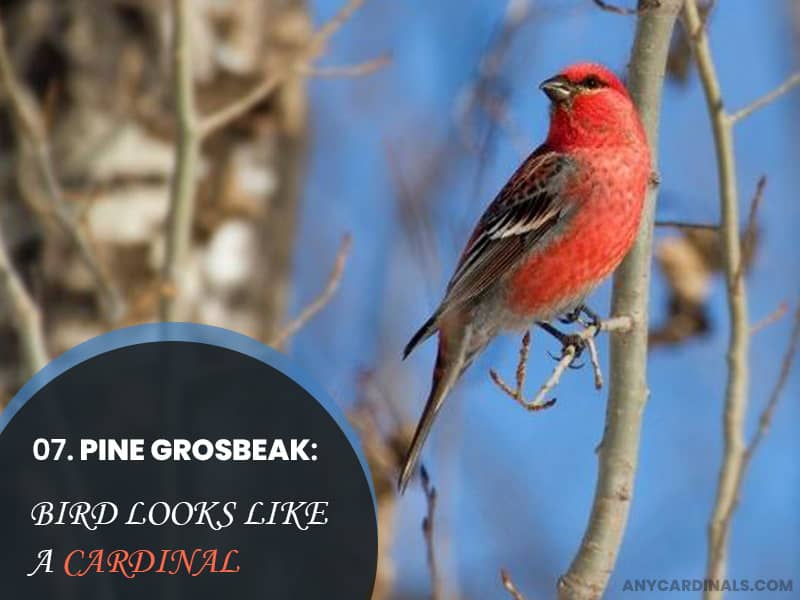What Bird Looks Like A Cardinal?
You may find no birders who don’t love to observe the eyegasmic bird species, cardinals. But, you will find many bird watchers who get confused in figuring out and separating cardinals from other look-alike birds.
And you can also undergo this situation and may wonder what bird looks like a cardinal. Numerous birds, including Pyrrhuloxia, scarlet and summer tanager, cedar waxwing, and more, look like a cardinal.
But if you know the similarities and differences between cardinals and those look-alike birds, you can easily identify each birdie. And that’s what we have shared in this content. So, let’s read.
Check out these related blogs:
- Why Does A Cardinal Have A Bald Head?
- Are All Cardinals Red?
- Why Are Male Cardinals Red And Females Brown?
01. Pyrrhuloxia:
Pyrrhuloxia is widely popular as a desert cardinal residing in Arizona, New Mexico, & Texas. Some birders confuse this birdie with northern cardinals due to its astounding crest.

Also, this bird species share the same body shape as northern cardinals. But by inspecting thoroughly, you can differentiate Pyrrhuloxia easily.
Below, we have shared this bird’s characteristics, similarities, and dissimilarities to help you understand it better. So, let’s read.
#Physical Characteristics:
Pyrrhuloxias come with gray or gray-brown plumage and feature a few red accents. The male one boasts the crisp gray feather, red face and crest, a red stripe in the breast, and a reddish tail.
In contrast, the female Pyrrhuloxia has buffy gray feathers with more minor red accents than the male. Both male and female birds contain yellowish bills and reddish highlights on the wings.
#Similarities:
Cardinal and Pyrrhuloxia are similar in many aspects; as such, both bird species eat seeds and fruit, have identical songs, and can live in the dense brush of desert washes.
#Differences:
Pyrrhuloxia can live in drier and more open areas that cardinals can’t, and this bird is more social. Speaking of physical differences, the Pyrrhuloxia have smaller, rounded, parrot-like, yellow bills.
Their predominant body color is gray; they boast the cardinal’s red color only around the bill and into the eye.
02. Scarlet Tanager:
The scarlet tanager is another bird that resembles the appearance of a cardinal. At first glance, many birders think it is a cardinal when it’s not. That said, let’s disclose how similar and different this bird is from a cardinal.

#Physical Characteristics:
Male scarlet tanagers are primarily red and have black wings and tails. Female scarlet tanagers boast olive-yellow feathers and come with dark olive wings and tails; after breeding, the male bird molts and develops female-like plumage.
#Similarities:
The male scarlet tanager exhibits the same bright red color as a cardinal. Besides that, the scarlet tanager falls in the same cardinalidae family.
#Dissimilarities:
The main difference between the scarlet tanager and the cardinal is that the scarlet tanager doesn’t have any crown like the cardinal. Plus, the scarlet tanager is comparatively small, while the cardinal is a medium-sized bird.
The last noticeable difference between these two bird species is that the scarlet tanager features a red face while a cardinal comes with a black mask on its face.
03. Summer Tanager:
The summer tanager is an eye-catching bird that loves to reside in the forest canopy. During summer, this birdie migrates to South America.

It can draw any bird watcher’s attention with its vibrant red color and make birders think they are witnessing a cardinal when it’s a summer tanager. Anyway, let’s now talk about its characteristics, similarities, and differences with a cardinal.
#Physical Characteristics:
The summer tanagers are medium-sized, bulky, and thick songbirds with large heads, and they have large, blunt-tipped bills. Male summer tanagers contain bright red feathers, while immature males and adult females feature bright yellow-green feathers.
Females also have green feathers on the back and wings. The male summer tanager’s feathers can turn yellow and red during molting.
#Similarities:
Summer tanagers have the bright red color of cardinals. Plus, they look similar in shape, and their perching style matches the cardinal.
#Dissimilarities:
The summer tanagers boast red feathers and have a comparatively longer and thinner bill than northern cardinals. Alongside that, they don’t have the same pointed crests, black masks, or feathers around their faces as northern cardinals.
04. Vermilion Flycatcher:
The vermilion flycatcher is a passerine bird found across South America and southern North America. This bird also comes with red-colored plumage and looks quite similar to the northern cardinal, yet it is distinctly different. How? Let’s find out.

#Physical Characteristics:
The vermilion flycatcher is a small-sized bird with a flat head, a barrel-like chest, a thin tail, and a straight bill. The male one comes with orange-red feathers and contains masks through the eyes.
The adult male vermilion flycatcher has a brown back, wings, and tail. On the other hand, female birds have gray-brown feathers with streaks on the breast and a salmon-red blush on the underparts. Lastly, their bills are black.
#Similarities:
The vermilion flycatcher boasts a red crown similar to the cardinal’s crest. Besides, it also has a small face mask, identical to the northern cardinal.
#Differences:
The significant difference between these two bird species is their beaks. While cardinals feature long beaks, the vermilion flycatchers come with comparatively shorter ones.
Also, unlike cardinals, they have black tails, and their primary feather color is gray.
05. Phainopepla:
Phainopepla is the northern representative found across the southwestern United States. You can also spot this bird in southern California, Nevada, Baja Peninsula, and Arizona deserts.

This birdie prefers perching on tall trees and shrubs and enjoys staying in dry woodlands. Let’s now describe its characteristics.
#Physical Characteristics:
Phainopeplas come with long, thick crests, tails, and red eyes. Besides, they contain white patches on their wings. Male birds tend to have glossy black feathers, while female ones have dark gray plumage.
#Similarities:
Phainopeplas have the exact shape of cardinals. Plus, they come with cardinal-like crests, eyes, tails, and legs.
#Differences:
Their feather colors set the cardinal and phainopepla apart from each other. While cardinals’ predominant color is red, phainopeplas’ colors are black and dark gray. Apart from that, phainopeplas have slim beaks and slender bodies, unlike cardinals.
06. Red Crossbill:
Derived from the passerine bird in the finch family, the red crossbill can amuse and, at the same time, confuse birders with its cardinal-like shape and plumage.

But you shouldn’t get confused; instead, learn the key differences between cardinals and red crossbills. So, let’s get started.
#Physical Characteristics:
It’s a medium-sized songbird with a notched tail and twisted bill. The adult male bird has brick red feathers, dark wings, and tails.
But females have yellowish underparts and brownish or olive-brown upperparts. They also have pale brownish streaking in their undersides.
#Differences:
The red crossbill’s feather color is more orange than red, and their bills are also different. While the red crossbill poses a twisted bill, a cardinal comes with a thick, conical bill. So, these are two major distinguishable features to look at to separate these bird species.
07. Pine Grosbeak:
We have listed another finch family member and cardinal look-alike in this article: the pine grosbeak. You can find this birdie in coniferous woods throughout Alaska, the United States, Canada & Siberia. Now, let’s check out their characteristics, similarities, and differences.

#Physical Characteristics:
The Pine grosbeak comes with a large, round head, thick and conical bill, and a long and slightly notched tail. The male features reddish pink and gray feathers, and the females have gray plumage with tints of reddish-orange. They also pose yellow on the head and rump.
#Similarities:
The male pine grosbeak has the same body shape as the male cardinal. Plus, it features a cardinal-like thick and conical bill.
#Dissimilarities:
The primary difference between the pine grosbeak and cardinal is their face. While cardinals have a black face, pine grosbeaks come with a red face.
Apart from that, the pine grosbeak contains a charcoal beak, while the cardinal features an orange beak. Cardinal has a long red tail, but the pine grosbeak boasts a medium-sized tail with a black tip.
08. Cedar Waxwing:
The last cardinal look-alike bird on this list is the cedar waxwing. You can find this bird in the northern half of the United States, Mexico, the Caribbean, Central America, and the northwestern part of Colombia.

That stated, let’s have a look at its characteristics and read the similarities and differences with cardinals thoroughly.
#Physical Characteristics:
Cedar waxwings feature a large head, short neck, and bill. They come with crests, and their wings are broad and pointed. Lastly, their tail is short and square-tipped.
#Similarities:
Cedar waxwings boast crests and black masks like the cardinals. They also have colorful wing tips and tails that look similar to cardinals from a far distance.
#Dissimilarities:
As you know, cardinals are bright red, but cedar waxwings are primarily brown. They often migrate from point A to B, while cardinals tend to stay in one place for a prolonged period.
Final Words:
So, that’s all about what birds look like cardinals. We hope next time you encounter any of the aforementioned bird species, you can easily identify them by observing the physical features we have already shared in this article.
However, if you found this content informative and assume that every bird watcher should give it a read, you may share our information-rich article with your friends on Facebook, Twitter & Pinterest.
Image Source: Canva.com/Photos

